Robyn Ryle's Blog, page 14
November 12, 2012
Madison Monday: the view from the window
Certain places seem to exist mainly because someone has written about them. . .a place belongs forever to whoever claims it hardest, remembers it most obsessively, wrenches it from itself, shapes it, renders it, loves it so radically that he remakes it in his image.
Inspired by this quote from Joan Didion sent to me by a friend, last week I set out to begin writing more intentionally about Madison as a scenic place. Scenic not in the sense of the most beautiful places or views, though of course, there will be some of that. But to write some about what Madison looks like, which is of course, connected to the kind of place Madison is. Last week, it was our streets. Today, it’s our windows.
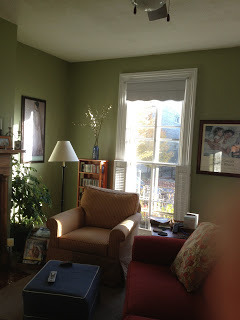
Rainy days make me especially appreciative of windows. They seem to become more present on a rainy day. You can see the pattern of rain splattered against them and watch the drops slide down their surface. You can hear the sound of raindrops pattering or hammering against them. You can appreciate the barrier they provide between you and the outside world. So it seems appropriate on what began as a rainy day in Madison to think about our windows.
When you live in a historic house, your perspective on accommodations is in danger of being altered, whether you like it or not. You are living in a space that was created by a group of people with a very different culture from your own. In many downtown Madison houses, the people who built your house did so sometime in the beginning half of the 19th century, and as the British writer L.P. Hartley said, “The past is a foreign country; they do things differently there.”
If your house was built in 1950, the space between yourself and the culture that created your house is a little less than the almost 200 year gap you live with in a historic house in Madison. And so you must re-think the meaning of even the most basic of features, such as windows.
The objects to which windows in a historic home are most closely related are not decorative items, but utilitarian ones; when you look at a window in a historic home, you should think about lamps and candles as equivalent objects. Windows in historic homes are primarily lighting devices. It doesn’t take much effort to notice that the windows in old houses are long and tall compared to most modern windows. They run almost the whole height of the wall in many houses. They are designed to maximize the amount of natural light that gets inside.
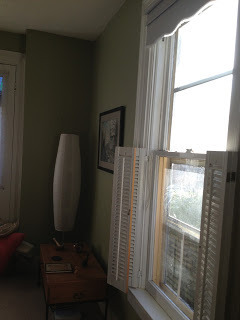
This is surely part of what can make living in a historic home such a pleasure–the light. You can contemplate here briefly all the implications of the historical shift that led us away from living in rooms that depended primarily on natural light to living much of our lives in places with artificial light. Or let me briefly contemplate them for you. We built power structures (political, energy-related and otherwise) that are dependent upon non-renewable sources to fulfill our lighting needs. We constructed lives in which we are unable to function without being provided with this energy from non-renewable sources. We violated a vaguely natural sense of time in which activities adapt to the rising and setting of the sun, rather than defying those realities. We told ourselves that on some physiological, psychological, spiritual and communal level exposure to natural light was unimportant. Contemplation ended.
The long, tall windows in historic homes also bring us up against the reality of our own modern ideas about privacy. Or rather, our modern obsession with privacy from the people with whom we share physical space; privacy in the virtual world is a whole different ballgame. You might think of the internet as a series of windows which we have constructed in order to allow all kinds of people to observe our private behaviors.
But as someone who grew up in 20th century housing with curtains and window shades and blinds, confronting these almost floor to ceiling windows in my own historic house was somewhat daunting. It wasn’t, after all, as if I were living out in the country where there was no one around to see into my windows. In fact, people were walking by my windows with an alarming frequency. How do you balance the need for light against the need for privacy?
I confess that I’m not sure if this is a solution that originates in the 19th century when downtown houses were built, or came along later, but the answer is surprisingly simple–shutters. Not all of the tall windows in my house are equipped with these devices, but I wish they were.
In some houses, there are two sets of shutters–some for the upper half of the window and some for the lower. In my house, there are only lower shutters. They are inside the house, of course. They are so easily moved that our cats can open them if they’re feeling even mildly determined (I confess I don’t know if the cats can close the shutters, as they seem largely uninterested in matters of privacy). But if you close the shutters over the lower half of your window, you have effectively prevented anyone on the street from seeing into your house while still allowing for all the light from the top half of the window to come into your room completely unimpeded.
Now let me qualify that a bit. Of course, if only your lower shutters are closed, people can still see into your house. What they can see are the corners in your ceiling and perhaps whether or not your ceiling fan is on. If they’re very lucky, at night they can see the weirdly reflected light of a television screen. Essentially they can see the upper half of your house, which unless you have a very strange kind of lifestyle, is not the part of your house in which anything much happens. What they cannot see is you sitting on the couch in your underwear, having an argument with your spouse, picking your nose...and so on. The lower shutter gives you the best of both worlds–privacy + natural light.
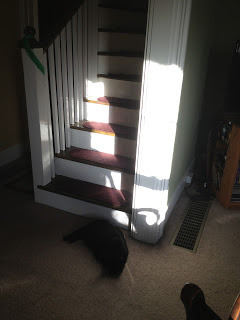
Our cat, not quite successfully keeping
up with the sunlight
I realize with some dismay at this point that I have not had much to say about any actual view from a window, so let me add another lovely feature of historic windows. I have never done a formal survey of how many houses downtown use shutters and how many do not. But you can get a rough sense if you go for a walk through a neighborhood at night. The houses with shutters give off a uniquely comforting kind of glow with the light that comes through the upper half of the windows. You can tell what colors they’ve painted their walls and you might be able to glimpse just the top half of a painting or the details of their crown molding. There’s something strangely satisfying and intriguing about being able to peek into half of a person’s house through a lighted window at night.
Of course, the windows look beautiful from the outside as well. If you study them closely, you might find an original window, identifiable by the way in which the glass has gone all wavy and distorted over time. But I appreciate the windows the most from the inside of my house. Before moving into this house, the presence, absence or shape of windows wouldn’t have even occurred to me as important when deciding to buy a house. I didn’t much think about having lovely windows, but now I don’t think I could live without them.






Published on November 12, 2012 14:34
November 11, 2012
Twitter vs. fuzzy socks
So, there’s a real post coming about Twitter. Perhaps several of them, with useful information about Twitter etiquette and why Twitter is good and how you can become rich and famous using Twitter. This post(s) will not be written by me, because as will quickly become obvious, I know nothing about Twitter. If I had to choose between Twitter and fuzzy socks, fuzzy socks would win every time.
The comforting simplicity of socks
I am a sock kind of person. I have socks with the goddess Lakshmi on them and socks with vegetables and socks with cats. Of course there are holiday socks and snowflake socks. I particularly enjoy knee-high socks, often with stripes. I have a pair of striped orange and black socks that double as Halloween/Bengals socks.

Perhaps my favorite socks are the fuzzy kind. Technologically speaking, these may be the best invention in the history of footwear. Some days, I think they may be the best invention ever. I confess that I’m not sure exactly what material goes into the making of fuzzy socks. I just know that this particular textile magic results in the perfect combination of soft and fuzzy. If someone made a body sock composed entirely of this fuzzy material, I might not ever wear anything else.
My favorite pair of fuzzy socks are a light brown, and they have a smiling face embroidered on the side, with two little ears attached at the ankle. I’m not sure exactly what kind of animal it is I’m supposed to be wearing on my feet, and I really don’t care. On a bad day, these socks constitute the thin line between me and a Greek tragedy-scale kind of chaos.
Tangling with Twitter
There’s an upgrade coming to You Think Too Much, and it seemed like as good a time as any to make the leap onto Twitter. As if the universe wholeheartedly agreed, I got an e-mail from someone who likes my blog and asked if he could follow me on Twitter. At the same time, I’m preparing to embark on the roller coaster ride that is trying to get a novel published, and Twitter opens up all kinds of resources for the countless multitudes who are riding along. For example, on Twitter you can follow along as someone finally signs with an agent for the first time, with all the attendant joy and congratulations. But Twitter, my friends, is no pair of fuzzy socks.
There’s the whole starting over again feeling that Twitter involves. I’ve spent about two years now slowly, slowly, slowly building up a following for my blog, so that now, I have the vague, if possibly fleeting sense, that someone out there is reading what I write. With Twitter, I have to start from ground zero, sending words out into the universe and hoping that eventually someone will find them.
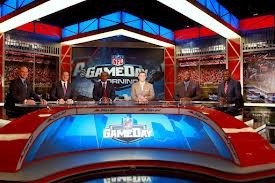
Then there are so many questions. Can I tweet Rich Eisen and ask him what the guys on Game Day Morning were doing before they came on air, or would that be rude and kind of stalkerish? How exactly do hashtags work? The first person I followed on Twitter was Chad Johnson, and I have to confess that I don’t understand about 80% of what he’s saying. What exactly am I supposed to Tweet and why? And who am I if I become someone who tweets?
Mostly, there’s the vague sense on Twitter that things are happening and there are things I should be doing, but I really have no idea what they are. It’s a fast-moving world on Twitter. I have no doubt that there are things to love about it. It was just a short seven years ago when I joined Facebook, and look at me now; I can’t remember the last time I went a whole day without checking Facebook. I’m not sure if that’s good or bad.
I’ve no doubt I’ll figure this whole Twitter thing out, and perhaps life will be better in some way because of it. At the very least, I will gain intimate insight into the life of Chad Johnson...assuming I figure out how to decipher his tweets. Perhaps I will find out what happens behind the scenes on Game Day Morning. Maybe I’ll get my novel published. In the meantime, I still have fuzzy socks.
You can follow You Think Too Much on Twitter....@think_too_much.






Published on November 11, 2012 08:51
November 9, 2012
Book Review: Morningside Heights

It’s been a while, but today, a real honest to goodness book review. My friend recommended and loaned me this novel by Cheryl Mendelson, set in, not surprisingly, Morningside Heights, a neighborhood on Manhattan’s Upper West Side close to Columbia University. The novel follows the Braithwaites–Ann, Charles and their three children–and a host of their friends and acquaintances who orbit around them through the streets, apartments, shops, buses and restaurants of this urban neighborhood.
Be warned that you may feel daunted by the first 40-50 pages of the novel, in which there is a great deal of character introduction. Characters who keep coming at you, right when you feel you’ve gotten everyone most thoroughly down. Characters who are described at great length with voluminous access to their internal thoughts. Be warned that this is one of the those novels with very, very long paragraphs, unbroken for pages on end by the comforting, white open spaces created by conversation. Do not let the preponderance of text, especially in the beginning, scare you away.
If you make it through the lengthy character exposition and the overwhelming amount of black ink on the page, you will find yourself rewarded with a lovely novel that reads like something from a previous century. It seems clear that Mendelson is a Jane Austen fan, and there’s certainly whiff of Austen around these novels in both the themes and the style. Much of the action centers on marriage, family, courtship and even inheritance. I found the novel a bit more weighty than an Austen novel might be, so perhaps it’s more like Mansfield Park than it is like Pride and Prejudice.
And yet, the novel is contemporary in the New Yorker obsession with psychotherapy and in the ways in which Mendelson has her characters talk about marriage, family and love. Of course, her characters live in a very different world than Austen’s did, though there is a scene that involves the breaking off of an engagement that could have leapt right out of an Austen novel.
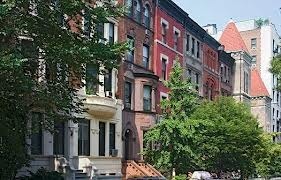
But in the end, much as can be said for Austen, this is a novel of the mundane. Some interesting things happen, but mostly people have children, raise children, and try to navigate the difficult terrain of a marriage. As novels of the mundane are some of my very favorite novels, I enjoyed Morningide Heights immensely. It is always a comfort to read about other people quietly working their way through life and to be able to identify the commonalities that all of us feel.
I leave you with a particular example of just this encapsulation of what it means to live a fairly ordinary life on the subject of marriage:
Charles gave up, and sat silent. Anne understood it all and even credited his good intentions, and he knew she did. The thing about being angry with one’s spouse, he thought, was that you instinctively turned to the same spouse for solace. Because he was angry with Anne, he wanted comfort–from Anne. Most amazing of all, she managed to sympathize with him in his anger toward her. She really felt bad for him. No wonder people didn’t want to get married anymore. It made your head buzz. Morris and Merrit were lonely and afraid of something, dying probably, but Charles remembered loneliness; it wasn’t as difficult as marriage.






Published on November 09, 2012 06:47
November 7, 2012
The day after: we are not divided
This morning I got in my car and turned the stereo from NPR to a Gillian Welch cd, signaling that now normal life will, once again, resume. I’m feeling a little hungover from a whole night’s worth of television news network watching after four years of cold turkey. Like an alcoholic who has her first drink after years of sobriety, I find it hard to resist the temptation to browse the web to see what everyone is saying about last night and where we go from here. But mostly I’m just glad it’s all over.
All the pundits last night kept talking about how we are now a nation divided, and a lot of the activity on Facebook this morning seemed, on the surface, to confirm that the loud tearing noise you were hearing was the sound of America being ripped apart. There was a lot of de-friending going on. A lot of angry statuses IN ALL CAPITAL LETTERS.
Maybe it’s where I live, but I don’t particularly feel like a nation divided. I don’t agree with everyone in Madison, and I sometimes wish people would find better ways to disagree. I know the election put a strain on some friendships in town. Maybe it ended some, but none of mine personally. I know that not everyone in town voted for the same people I voted for, and quite frankly, that would be kind of weird and disturbing, anyway. Some of the people I consider friends probably voted for candidates whose views I disagree with about as strongly as you can possibly disagree with something.
But I know who they are and I can see what they do outside the voting booth. They organize and support some of my favorite local events. They take care of their neighbors. They play music together. They help give our communities things like the farmers’ market and a community garden. They sit at the bar and drink beer with us. They practice compassion and patience. I can see through their actions that they love Madison and the people who live here.
I don’t know what it was like at your polling station yesterday, but in Madison, people smiled at each other. They exchanged some gossip. They got to see folks they might not have seen in a long time. Sometimes they hugged.
Perhaps this is just one of the blessings of living so far away from the places that the rest of the world perceives as the center–the places where all the important things happen. Perhaps it’s better out here in the flyover states. Perhaps out here we can afford a kind of tolerance. Or maybe I’m just incredibly naive.
But maybe it’s that we’re able to see the people around us as more than just a person pushing a button on one Tuesday in November. Pushing that button is certainly important and crucial and a little bit miraculous. But it’s not everything. Life goes on and if we can’t live with each other on one day every four years, how can we live with each other every other day in between?






Published on November 07, 2012 09:37
November 6, 2012
A list of things that will not be different tomorrow, no matter who wins....
Okay, I said I wouldn’t write about the election, but I lied. This post is mostly about providing some comfort for myself, but here’s hoping it provides you some comfort, too.
Things that will not be any different tomorrow, either way:
1. The sun will rise and set. I am almost 100% certain that this will happen under both Obama and Romney, and this is in spite of my already well-documented post-apocalypse paranoia.
2. I will still have to get my daughter up and off to school in the morning. Also, she will take the exact same amount of time to eat her waffles (it seems like about 30 minutes) and will probably still get out to the bus stop with exactly 24 seconds to spare before the bus pulls up.
3. The leaves on the tree down the street will still be a lovely yellow, a little last burst of fall color before the naked, winter branches take over.
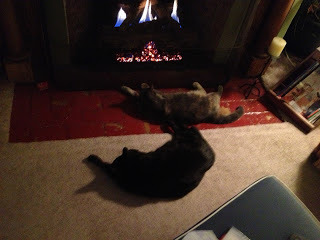
Our cats, oddly unaffected by election results
4. My cats will continue, from time to time, to throw up on the floor. This, I have learned, is unaffected by any external stimulus at all–type of cat food, use of “hair ball control” products, brushing, gentle coaxing, trips to the vet, or Presidential elections.
5. I will still have papers to grade. Even if the apocalypse comes, I will still have papers to grade.
6. I will still have a six-pack of Three Floyd’s Alpha King waiting for me in our beer fridge. Okay, this is perhaps a dicey one. There’s a chance, depending on the results, that some member of our household might be seeking liquid comfort tonight, but I’m betting at least a couple beers will still be left.
7. My mother and father will still love me. I have almost forty years of experience now testing this, and I haven’t broken them yet. I feel certain another election will not be the straw that breaks the camel’s back.
8. The river will keep flowing. It sounds like a small thing, but if you’ve ever lived next to a river, you know what a wonderful blessing it is.
9. There will still be plenty of things to complain about, if you’re so inclined. See #4 and #6.
10. I will still live in the lovely little town of Madison, Indiana, where we mostly do our best to be kind to each other regardless of how you vote.
Happy day after the election (and here’s hoping I’m not wrong about #1)!






Published on November 06, 2012 14:53
November 5, 2012
Madison Monday: The view from the street
A few weeks ago a friend of mine who grew up in Madison sent me this quote from Joan Didion because it reminded him of me and my blog:
Certain places seem to exist mainly because someone has written about them. . .a place belongs forever to whoever claims it hardest, remembers it most obsessively, wrenches it from itself, shapes it, renders it, loves it so radically that he remakes it in his image.
It’s a lovely quote, and I started a very long entry about how I’m not sure if I’m really worthy to be this person where Madison is concerned. There are certain places that for me are always filtered through the words and images of the people who wrote about them. Mississippi is filtered through Faulkner, Eudora Welty, Richard Wright and Lewis Nordan. I visited India mostly because I fell in love with the fiction of Rohinton Mistry. And London is layered with hundreds of writers who told me all about the city before I ever set foot there. You can see where thinking about yourself in this kind of company could be fairly intimidating.
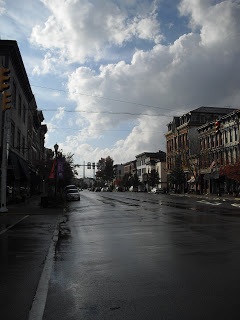
I’m still not sure if I’m worthy of such a quote, but in asking myself this question, it occurred to me that it might be worthwhile to write about some of my favorite scenic aspects of Madison. And here I’m not talking necessarily about “scenic” in the tourist sense. In fact some of the things I plan on writing about are considered far from “scenic” by many people. I often write about Madison as a community of people, or the businesses in Madison, or the events that happen in Madison. But this is Madison as scene, Madison as setting. This is more about what Madison looks like, which for me, is connected deeply to all those other things.
So, one of my favorite things about Madison as a scene are the streetscapes. Every morning, I walk out my house, load up my car, and then before I open the door to get in my car, I take a look down 2nd Street. From our house, you can see all the way down to the store that used to be the JayC. And then because the whole of the town does a little dog-leg at West St., I can see the buildings beyond that curve laid out, too. It is a thing of beauty that I try to take a moment to appreciate before I set out about my day.
The view down Main St. is similar. If you stand anywhere vaguely close to the place where West St. turns to follow the curve of the river, you have a lovely view down the street. You can see the buildings on the straight part of the street in front of you, and then the buildings curving away around the corner from you past the place where the town bends. I remember after I had first bought my house downtown and started actually paying attention to such things, I would be driving into downtown from the west, and wonder which steeple that was, visible from far down Main St., looking as if at first there’s a church right in the middle of the street. And then I realized it was the steeple from the church right next door to my house, which is not on Main St. at all. But because of the particular angle of Main St., from far away the steeple of Prince of Peace stands out in the distance directly above Main St. There was something so incredibly delightful about this, the idea that from almost anywhere in town, I could see exactly where home was.
It’s hard to describe how satisfying the view down the streets of Madison is, but I’ll give it at try.
Scale
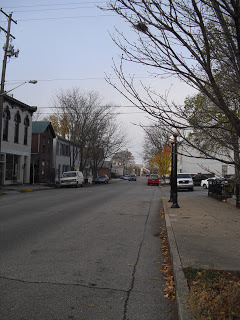
First, I think there’s the scale. In Manhattan, you can gaze down streets that are lined with buildings on both sides just like Madison. But in most parts of Manhattan, the buildings are massive. They draw your eyes up and up and up, and might make you feel a little claustrophobic, as many parts of Manhattan feel to me like the bottom of a very deep gorge. The overall effect is to make you feel small. Here is a city that does not appear to have been built for me as a human, but for some larger creature (and I would argue the larger creature is capitalism or commerce, but that’s a whole other post).
In Madison, none of the buildings are taller than four stories. They never become so ambitious as to block out the sun and almost all of them look like someone could live in the buildings, even if they may not be right now. The streets of Madison look as if they were built for humans.
Space
But spacing is important, too. The buildings in Madison are close together, a fact that makes them less attractive to our modern tastes. In fact, many of the buildings are actually connected, an idea that truly strikes terror into the hearts of many Americans. I have to share a wall with someone? Yes, and it can actually be quite a pleasant experience.
If you don’t believe spacing is important, go try and walk around on the hilltop on Clifty Drive. This, unfortunately, is what most of America now looks like. The place is designed to accommodate cars, and not people, which is why no one walks there. But even if there were sidewalks, there’s too much space for anyone to feel very comfortable walking around. Too much space between the buildings. Too much space between the buildings and the street. Where the streets of Madison feel like comfy little valleys, places like Clifty Drive feel like open desserts. A dessert can be a beautiful place, certainly, but not a space that screams, “Welcome, humans!”
Buildings spaced close together say, "This is a place built to the scale of a human walking." Getting from one place to the next doesn’t seem so bad, and in fact, I can see down the street exactly where I’m headed.
Variety
The streets are also made beautiful by the variety. There are different types of buildings along the street at different heights, different shapes, different colors. There’s something to be said for some uniformity. In Madison, that uniformity mostly takes the form of distance from the street. Take the store that used to be the JayC. It’s not consistent with the architecture of the rest of the town. But it’s still set close to the street. The parking lot, rather than being in front of the building, is at the side.
When everything looks exactly the same on a street, we start to think institution. Institution could mean college or university, which is a good kind of institution. But in most cities and towns, a place that looks institutional is likely to be public housing, and no one–usually including the people who live there–like public housing. We could have done a lot for the beauty of our towns and cities just by taking the small effort to make public housing look slightly different, building by building.
The beauty of the bend
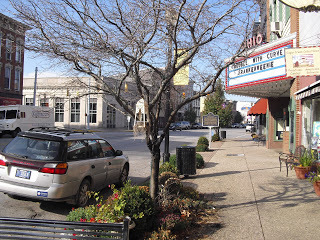
Finally, it’s all about the bend. I said earlier that the whole town bends at West St. because of the river, but truthfully, I have no idea why it bends there. Maybe they were following the contour of the hillside or of Crooked Creek. Or maybe the folks who platted the town were just brilliant, because the bend, it turns out, is a beautiful thing.
In new urbanism, a particular school of urban design, they’re very into streetscapes. Much of what I’ve been talking about here comes straight from new urbanism. They especially like the idea of public buildings being given a place of prominence by sitting at the terminus of a street. In many towns, the courthouse would sit in the middle of a town square, and all the streets would radiate out from there. So at the end of all your main streets was a view of the courthouse, and this design reflected the importance of our public institutions.
Obviously, Madison didn’t follow that design. What you see from either side of town–the west side or the east side–is not a large public building being revealed. You just see more of the town. In the place of a public institution in Madison, we just see more of us. More buildings, more businesses, more houses. Instead of placing a courthouse or a library or town hall as the focal point of our streetscape, the focal point just becomes more street. What does that say about us? In Madison, what’s most important is more Madison.
On top of all that, you can add the view from specific streets and locations in Madison. Looking north on St. Michael’s Avenue you get a view of the beautiful church sitting on the hill above you. On the south side of Main St., almost every north/south street terminates, not in an impressive building, but with the river, rolling quietly by right there in front of you. From almost everywhere in town, you can look up and see the hillsides above you, on either side of the river, doubling the valley of the streetscape. We are living in valleys within valleys. Which is really a whole other post...
My next scenic obsession in Madison...the power plant!
Upgrade: Sometime in the next couple of weeks, You Think Too Much will be experiencing an upgrade. If you already use the address www.you-think-too-much.com, nothing will change but the look of the site. If you use the old blogger address, http://kentuckiana-rrr.blogspot.com/, you will need to update to www.you-think-too-much.com.






Published on November 05, 2012 08:17
November 1, 2012
Living in the Fall
As of Monday afternoon in Madison, the only sign of the apocalyptic approach of Hurricane Sandy was a delightful leaf swirling that was happening along the streets and roads. In downtown Madison, residents can rake their leaf piles right on the curb, certain in the faith that the earth-shatteringly loud leaf monster owned and operated by the city will come suck them all up, grind them into little bits, and shoot them back out into the air. This is infinitely more convenient than having to load them all up in composting bags, but when the wind blows like on Monday afternoon, it can seem somewhat counter-productive.
As many of you know, I am an avowed non-follower of the news, but the size of Hurricane Sandy might be measured by even my inability to avoid any sign of her coming. She kept popping up on Facebook, and then on The Weather Channel app on my phone. And so for better or worse on Monday, I found myself actually looking at The New York Times page for what was probably the first time in six months. And then, as if my years of being on the newsless wagon could be erased in just one simple breeze from an impending storm, I found myself resisting the urge to turn on The Weather Channel, or CNN, or something that would give me frantic, panicked, up-to-minute news from people standing in the middle of the storm, risking their lives and limb for...something. Perhaps to drive up my own panic until I would willingly admit that I cannot survive without people who are paid to whip me into a constant state of panic.
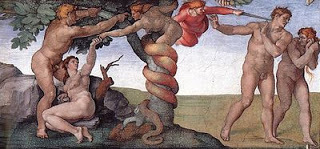
On The New York Times webpage, things looked bad even on Monday. By Wednesday morning, things looked big Hollywood, blockbuster apocalypse movie bad. So bad that a whole internet industry sprang up in sorting through which photos were real and which were in fact, stills from big Hollywood, blockbuster apocalypse movies. And I’m certain that everyone else out there who lived through a storm that was more than some swirling leaves and strong winds knows how bad the storm was in ways I cannot even begin to imagine. Just reading the accounts of people who died in New York was enough to break your heart: two friends crushed under a tree while out for a walk; a woman electrocuted in her driveway trying to get pictures of the storm; another man swept out of his house by rising waters and through a window pane.
But in Madison on Monday afternoon, none of this had happened yet, and the swirling little leaf storms were beautiful, as was the sound of all the wind chimes around town singing out about the weather. I wondered, as I often do, why we feel compelled to work so hard to prevent the leaves from dancing around our streets? Why do we rake them and blow them and suck them up with large gas-powered machines? Is it really the leaves against us? Are the leaves really our enemies? If we live in a world where leaves need to be so carefully controlled and disposed of, have we perhaps already lost?
The Fall
I left Christianity in my rearview mirror sometime in the 1990s, but I found myself yesterday afternoon thinking about the Fall. Yes, that Fall, with a capital ‘F,’ as in original sin and expulsion from the Garden of Eden. Maybe I was thinking about it simply because it’s more poetic than thinking about the apocalypse. I was driving up to campus, the cloudy doom that is Hurricane Sandy behind me, a sign that the weather is approaching from the opposite direction, that the world has been turned upside down. A sign that something is wrong in the world. There were little flocks of birds swirling around in a dance that echoed what the leaves were doing closer to the ground. I’ve heard that hurricanes and tropical storms can be a boon to bird watchers, blowing hordes of rarely seen sea birds, song birds and tropical birds to unlikely places. Were these rare birds I saw, or just run-of-the-mill southern Indiana birds mildly freaked out by some undetectable sign of the coming storm?
But mostly what had me thinking about the Fall were the deer. There were two standing in the middle of the road as I crested a hill, a doe and her fawn, standing stock-still next to the state park entrance. The car in the other lane had already stopped, and I slowed down, and they disappeared, back onto the side of the road from which they had come. Which was probably best. On the other side of the road is the power plant, and an 8 foot fence with barbed wire on the top. No obstacle to deer, but what do they do once they’re there, inside the power plant? What’s there for them that could possibly be safer or better than what’s in the state park?
I worried about them. I worried about their lives. I worried about the incomprehensibility of cars and roads and power plants. I worried about it even before I saw, just a half mile up the road from the live deer, the construction crew with the bodies of two dead deer piled up in the back, waiting for their own disposal. And I thought, “We are already living in the Fall. It has happened. It has already come and gone and become perfectly normal.”
Leaf by leaf
Meanwhile, a storm was blowing in that would re-acquaint the population of one of the cities that is in some ways so far removed from its status as a natural place that they have an actual dirt museum with the hard reality that none of us will be able in the end to escape the fallout of our environmental disregard. For me, New York City more than any place in the United States is a city, and not an environment. None of your L.A. obsessions with water, or your Denver view of mountains. No history of whole city blocks being filled with cattle headed for the slaughter like Chicago. Before New York expanded beyond the tip that was New Amsterdam, they literally leveled out the landscape that was there, an act which seems in many ways to exactly epitomize the spirit of the city and our country, perhaps. We will drain these swamps, send this river underground, flatten these hills and impose the exacting and oblivious order of our own human grid. It is part of what makes the city such a wonderful and amazing place, this insistence that it is a definitively human place, a world unto itself. New York is always changing, but that change is human in its causes and human in its consequences. New York City, we would like to believe, is no place for nature.
But it is, of course, nature’s place, because every place is nature’s place. Hurricane Sandy gave everyone a view of what the New York might look like someday, remade by an ocean that is not just temporarily surged into its neighborhoods, its city streets, its subways and its high rises. The verdict on whether Sandy was a product of global climate change is out, and will take years for scientists to definitively say, but it is undeniable that images of parts of New York City underwater are becoming eerily more common in the last couple of years.
Here in Indiana, we are trying to forget the record-breaking drought of the summer, but finding it hard in the grocery store, where the failed corn crop has driven up the price of food. We braced ourselves for the second hurricane to affect the state in a four year period, and luckily were mostly spared here in Madison. We have whole systems in place for getting rid of the leaves and the carcasses of dead animals that pile up along our roads.
We are fallen. We are living in the Fall.
They are all of a piece, you see. The need to blow the leaves into neat little piles with our gas-powered leaf blower. The roads we drive on out here in the country every day strewn with the dead bodies of animals. The storm and the panic we churn out in its path. The shocking vision of New York City streets underwater.
It is apocalypse by attrition. And it is not a meteor falling from the sky; it is not random death from above. It is an apocalypse we hasten each and every day. It is an apocalypse we have been urging along for decades now. It is an eventuality we embrace day by day. It is a choice we have made. Is it because we didn’t really know that the apple was bad for us every day when we took a bite? Or do we just not care?
The Fall does not happen all at once, with the vision of a shiny apple when even small children know not to take candy from strangers. It is not as simple as that. It is slow. The apocalypse comes not all at once, but in inches. Bit by bit. Day by day. Storm by storm. Deer by deer. Leaf by leaf.
But we are fooled all over again, each and every time.






Published on November 01, 2012 04:09
October 29, 2012
Madison Monday: Joey's place
Musicians need a place to play. People need to listen. Towns need a place where both of those things can happen. In Madison, that place is JoeyG’s, and the person who helped make that happen was Joey Gayles, who passed away this weekend.

photo courtesy of joeygs.com
I didn’t know Joey well at all, but as a place-ist, I believe the places we make are a reflection of who we are. I know the place Joey helped to make, and so I know he was a generous person who loved music and art. I know that the place he made has been a central part of the social and cultural life of our town, and so I know that Joey cared about Madison.
JoeyG’s is the place where I first met and hung out with many of the people who would eventually become my friends and my community. It was for years the place where a group of us would get together every Wednesday night to drink beer and talk about the unimportant things that needed to be talked about. It was a different version of our own little pub, our own little barbershop, a place where you could show up or not, but everyone would be happy to see you when you did.
JoeyG’s is the place where, in that little group, I got to know my husband. It is the place where, after much persuasion, we went on our first “date.” It is the place where the two of us sat in one of the front tables that is encased by window, looking out onto the heart of downtown Madison in the most satisfying combination of people-watching and privacy. It was at that table that my husband convinced me to please, please give him a chance, over a veggie burger and a Bass Ale.
JoeyG’s is the place where several years later, my husband and I stood up on the stage, singing and playing for a room full of friends. It is the place where countless other people were also able to do that for the first time. May it continue to be that place.
JoeyG’s is the place that always has art on the wall, and it is always local art. It is the place where you probably first saw the work of many of our local artists. It is always a place with something interesting on the walls, even in the bathroom, where you can hang with Janis Joplin and Tiny Tim.
JoeyG’s is the place where, even if you don’t necessarily stop by, there is always music. Dixieland music, blues music, punk music, rock music. On your way to somewhere else, you can glance in those big glass front windows and see someone making music. If you want to hear music in Madison, it is the place to go. It is a musician’s home. It is the place where music matters.
I didn’t know Joey Gayles very well, but I know the place he made. And so I know Madison will miss him.






Published on October 29, 2012 06:01
October 25, 2012
My many states of limbo
This is at least the third post I have started this week, with no success as of yet in completing something that seemed good enough to go public. Writing experts will tell you that nothing you write is a waste, so perhaps someday the scraps of those other posts will cohere into something, but for now, I’m holding out hope for attempt #3. I am writing my escape from limbo.
The week after Fall Break is a kind of limbo period in general. You come off an actual break and a short week of classes. You know somewhere in your head that the semester is now halfway over, and so technically, it’s all downhill from here. But that’s still a lot of weeks ahead of you, and a whole month until Thanksgiving. So you know the end is closer than it was, but still not quite close enough.
I’m in limbo because I finished the last book in the Chief Inspector Gamache series. I won’t give anything away, but it was a hard ending. I finished it at night, and it took every bit of willpower I had not to lean over and poke my husband in bed, wake him up and tell him how distressed I was. Distressed at the ending, but more distressed at the prospect of having to wait for the next book to come out. I feel certain things will get better, but, as is often true in life, it might take a while. And in the meantime, what do I read?

As if that wasn’t enough, we also find ourselves in television limbo. Last night my husband and I finished the last episode of the BBC television show, Sherlock. If you have not watched this show, stop reading right now. Stop everything you are doing and go watch....Now, isn’t that better?
I cannot even begin to articulate what is so good about this show. There is, of course, the delight of the “wink, wink, nudge, nudge” approach the show takes towards the original material. The hats Holmes and Watson are famous for wearing show up, but as an accidental attempt by Holmes and Watson to disguise themselves which comes to haunt them as they become more well-known. The last two episodes in Season 2 are called, “The Hounds of Baskerville” and “The Reichenbach Fall,” and this perfectly sums up this show’s approach to the Arthur Conan Doyle stories. They are like the original, but with the most delicious little twist. Not Reichenbach Falls, but the Reichenbach Fall. Get it?
The acting is brilliant. The backdrops of London streets or the English countryside are perfect. The cinematography is gorgeous. The writing is so crisp you’ll be reaching for your remote control just to hear what they said one more time. It is just perfect.
Why can’t Americans make televison like this? Well, we do, but you have to pay extra for it on HBO while our public television station barely survives. Sometimes I look at the British and think living in a dying empire isn’t such a bad thing at all. But then I worry that in a dying empire, the central features of your national character become amplified. For the British, it’s keep calm and carry on. I tremble to think what aspects of our American national character would be amplified in our own dying empire. Perhaps they already are.
Outside here in southern Indiana, there’s a kind of weather limbo, too. I hesitate to even call it an Indian summer, as that used to designate an unusual patch of warm weather in the fall. I’m not sure if this is unusual anymore, but it’s in the 80s today as October slips away. This would probably be lovely had I not just read yet another novel with an environmentally-induced apocalypse.
Even without the fear of apocalypse, it is time for cooler weather. Time for sweaters and scarves and coats and bonfires and chilly walks through the piles of fall leaves. Instead it feels not quite like summer and not quite like fall. Limbo. Again. At least I got a post out of it.






Published on October 25, 2012 12:54
October 22, 2012
Madison Monday: total institutions, greedy institutions and coming home
It was another lovely week in Madison, where many things happened, and also not much at all. It was a short week of classes after our Fall Break, which is always a nice thing. All the kids from the Madison Consolidated school system were also on break, and many of them with parents who work at the college were wandering around the campus, sort of like the kids in The Lord of the Flies , though hopefully with less violence.
It is that time of the year for pumpkin panna cotta at the 605 Grille, which I can report, was quite delicious. On Friday night, we sat at the bar and caught up with friends. On Saturday night, we went to our first Halloween party, a great time only made better by our host's outstanding taste in beer. And then to a housewarming party for another friend, which all made us feel very popular and lucky in the community which we have here in Madison. And got me thinking about different kinds of communities.
When I first imagined being a college professor at a small liberal arts college, I imagined that my fellow scholars and students were all I would ever need in the way of community. Many professors, my husband and I included, choose their profession because they decided at some point that they never really wanted to leave college. As a an undergraduate, I looked around and said to myself, “I want to stay right here forever.” And so, here I am.
There’s a concept in sociology called a total institution, developed by Erving Goffman. A total institution is an isolated, enclosed social system whose primary purpose is to control most aspects of its participants’ lives. Think of prisons, asylums, boarding schools, military bases, and, well, small, liberal arts colleges. I’ve often asked students whether their college is a total institution, and it’s an argument that’s pretty easy to make, especially in a fairly isolated setting like ours. Or as our alma mater says, “far from mart and town.”
As a professor at a small liberal arts college, there is certainly pressure to allow the institution to control most aspects of your life. Lewis Coser, another sociologist, might call colleges greedy institutions, and if you’ve ever been a part of a greedy institution, you probably don’t need a definition. A greedy institution makes total claims on their members and attempts to encompass within their circle the whole personality. In simpler language, a greedy institution will eat you alive. If you let it.
This all sounds very ugly, but when I first started teaching, I wanted my job to encompass my whole life. I thought I wanted to hang out with all my colleagues, having deep intellectual conversations about Foucault and post-modernism. I wanted to spend lots of time with my students, have them over to my house, and live life as if it were all just one big, happy, continual classroom. I imagine that some people live this life and find it quite satisfying and fulfilling and engaging, but I’ll confess that at some point, I had to escape the asylum.
Which is all a complicated and convoluted way of saying that at some point I realized that for me, being a college professor was best imagined as just a job, and not as a way of life. It’s a very good job and a very rewarding job. I’m paid a quite decent amount of money to read books and sit in a room and talk to people about them. I have ludicrous amounts of job security in a very tenuous economy. It really doesn’t get much better than that. But as a greedy institution, a college will attempt to draw you into many, many things that have very little to do with the most important part of your job–being in the classroom. It will invite you to obsess over pointless minutiae and infuriating politics. You will find yourself engaged in heated arguments over something that matters to only 20 or so other people on the planet. And it is in those moments that you feel like you may very well have landed in a mental asylum.
When I first started interacting more with people from the local community that exists outside of the college, I would tell them I worked at “The College,” assuming, of course, that they’d know which one. But they didn’t. Which was puzzling and a teeny bit annoying to me at first, but is now something for which I am quite grateful. Why should anyone know which college? It is, after all, just another place to work, isn’t it?
When I leave campus each day, I don’t interact with people anymore as a college professor. I’m just another downtowner, or a regular at the bar, or a parent, or a neighbor. Maybe I’m the woman who writes that crazy blog. But I am off the reservation, happy to be able to say I work in the asylum, but I don’t live there. What a blessing to have that choice and at the end of each day, to be able to come home to Madison.






Published on October 22, 2012 07:54



